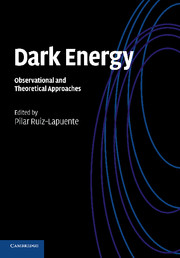Book contents
- Frontmatter
- Contents
- List of contributors
- Preface
- Part I Theory
- Part II Observations
- 5 Foundations of supernova cosmology
- 6 Dark energy and supernovae
- 7 The future of supernova cosmology
- 8 The space advantage for measuring dark energy with Type Ia supernovae
- 9 Baryon acoustic oscillations
- 10 Weak gravitational lensing, dark energy and modified gravity
- Index
- References
6 - Dark energy and supernovae
Published online by Cambridge University Press: 05 July 2014
- Frontmatter
- Contents
- List of contributors
- Preface
- Part I Theory
- Part II Observations
- 5 Foundations of supernova cosmology
- 6 Dark energy and supernovae
- 7 The future of supernova cosmology
- 8 The space advantage for measuring dark energy with Type Ia supernovae
- 9 Baryon acoustic oscillations
- 10 Weak gravitational lensing, dark energy and modified gravity
- Index
- References
Summary
Introduction
The use of SNe Ia as calibrated candles has led to a fundamental discovery: that the rate of the cosmic expansion of the universe is accelerating (Perlmutter et al., 1999; Riess et al., 1998). At present, the data gathered on the expansion rate do not disclose whether the acceleration is due to a component formally equivalent to the cosmological constant introduced by Einstein (1917), whether it is due to a scalar field or other component of the universe unaccounted for so far, or whether we are finding the effective behavior of a theory of a wider scope whose low energy limit slightly departs from general relativity. The presence of an energy component with negative pressure (still undistinguishable from the cosmological constant Λ) and the nature of this new component, commonly termed dark energy, is a major challenge in cosmology and in fundamental physics.
The bare Einstein's equations (without cosmological constant) for a universe with a Friedmann–Robertson–Walker (FRW) metric and dust-like matter imply a continuous deceleration of the expansion rate. However, a universe containing a fluid with an equation of state p = wρ with index w − 1/3 overcomes the deceleration when the density of this fluid dominates over that of the dust-like matter. In this context, the cosmological constant, if it is positive and added to the equations, balances the deceleration by acting as a fluid with an equation of state p = −ρ.
- Type
- Chapter
- Information
- Dark EnergyObservational and Theoretical Approaches, pp. 177 - 201Publisher: Cambridge University PressPrint publication year: 2010
References
- 1
- Cited by



